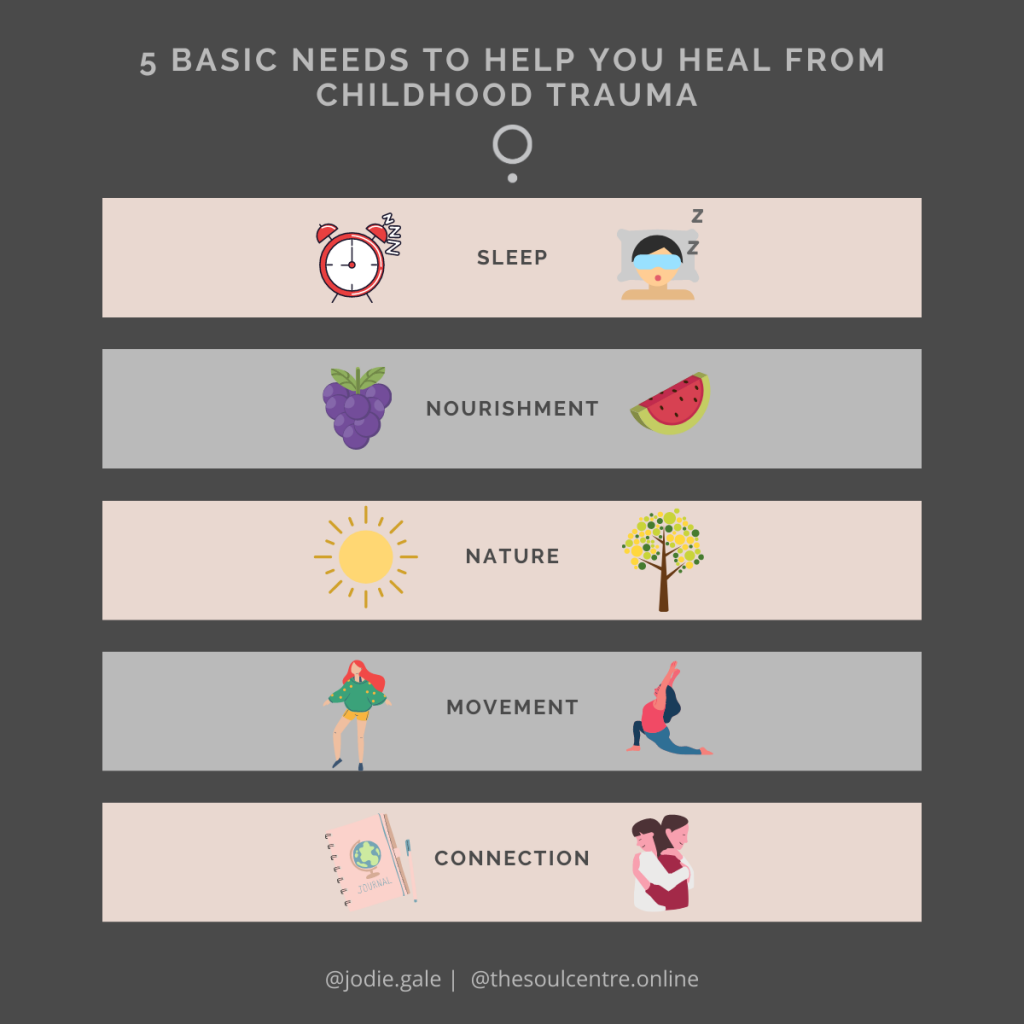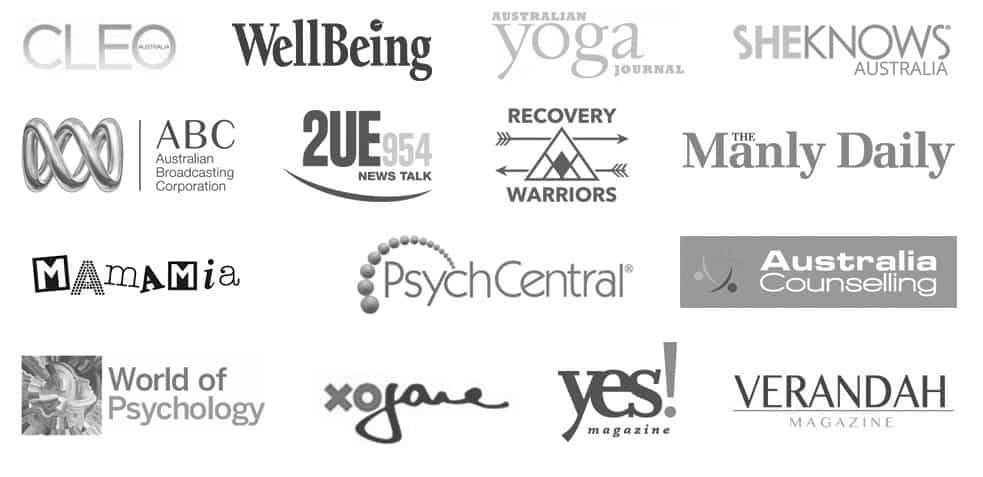
When it comes to basic needs, people who suffer from complex trauma typically have (or had) parents who were unavailable in some way (e.g., depression, addiction, narcissism) and who lived in a household where the primary care system was too absent, too controlling or too chaotic. The child often had to be the adult.
Often, the parents’ needs were primary, the basic needs of the child were not met, and they now neglect their basic needs or feel undeserving of having needs at all.
In order to feel safe in the world, the child (or, as is our case as adults, the inner child) needs the following foundations to feel safe and secure. In other words, even before esteem, love and belonging needs are met, our inner child needs an inner healthy adult to meet her basic needs.
To heal developmental trauma as adults and really experience a life after trauma, we need to take care of the younger part(s) of us that still exist. If we don’t, she searches outside for another adult to take care of her (e.g., co-dependency) or uses addiction or food to sooth her feelings or meet her needs.
The baseline for healing is safety and security.
So, we start just like we would with a child. We build safety by building a routine: not too controlling, not too wishy-washy. We want a good balance of love (the feminine, taking care of ourselves) and boundaries (masculine, protecting ourselves).
Here are the five basic needs you can fulfill to support your inner child as you heal from childhood trauma as an adult.
1. Sleep
Sleep is one of the most important foundations to support the healing of childhood trauma, simply because it is one of the most important foundations for both physical and mental health. Without good sleep, we experience consequences like fatigue, short temper, a lack of focus, and brain fog. Who wants to do healing work when all they can think about is a nap?
It’s normal, okay and not at all overly indulgent to arrange your life and living space to ensure that you get the best possible sleep. Here are some ideas:
- If possible, create a sleeping-only space in your home that’s dark, quiet, and at the temperature you sleep best with.
- Be as consistent as you can about the times you go to sleep and get up.
- Avoid large meals, caffeine, and alcohol before bedtime.
- Being physically active during the day may help you get to sleep more easily.
Some sleep-related conditions like sleep apnea can also carry quite a bit of shame with them. You deserve good sleep, even if that requires a trip to a sleep doctor.
2. Nourishment
In a world where we’re told to eat as little as possible, in as few meals as possible, this is going to sound a bit out there, but it’s really important that we nourish ourselves properly.
As a Vegan and Vegetarian Nutritionist, a Carolyn Costin Eating Disorder & Mind Body Eating Psychology Coach, my recommendation is to plan ahead for 3 meals and a couple of snacks each day.
Do start by including the daily recommendations of vitamins and minerals such as calcium, at least five serves of vegetables and two serves of fruit, from all the wonderful types and colors available.
Don’t restrict macro-nutrients: protein, carbohydrates and fats.
The Centre for Clinical Interventions via The R.E.A.L Food Pyramid says,
Many people believe that all fat is bad or “the less fat I have the better”. However, diets that are too low in fat may be detrimental to health, as our body needs some fat to function normally.
Not eating enough carbohydrate can lead to tiredness, fatigue, dizziness, irritability, and low blood glucose levels. It can also precipitate binge eating,
particularly at mid-afternoon (around 3-4 pm) when blood glucose levels naturally drop and cravings commonly kick in.Protein is needed for growth and repair of body tissues and plays an important role in all functions of your body. If you are vegetarian, it is important to replace animal proteins with iron-rich substitutes.
The R.E.A.L Food Pyramid
And finally, add food you enjoy so that you don’t ever feel the need to restrict or binge. Feeling free in what you eat — or letting your body guide you in what to eat, also called intuitive eating — is the key to avoiding weight cycling, disordered eating behaviors and giving yourself a base of support for healing.
Nourishment also means going for coffee and cake with a friend, or having a donut if that’s what you feel like eating. We eat for so many reasons other than pure energy, and community and connection (more on that below) are important reasons for us to eat, too.
Nourishment for Specific Needs
Rejecting the diet mentality means rejecting the idea that a specific food or eating pattern can ‘fix’ you.”
When we talk about eating intuitively, it’s easy to think “well, I can’t eat whatever I want because I have a chronic illness.” Of course we also need to respect all of our body’s needs, including those set for us by allergies, sensory issues, eating disorders, or a variety of short- or long-term illnesses.
I recommend using these guidelines created by Carolyn Costin for what’s called “conscious eating” to eat as intuitively as possible while respecting your body’s medical needs. If you have an eating disorder or struggle with disordered eating behaviors, trauma may also play a role in how you interact with food. It’s important to seek the help you need to resolve both trauma and disordered eating.
3. Fresh Air, Nature & Sunshine
We need at least 10 minutes in sunlight to activate Vitamin D.
Experiencing the world outside our homes, workplaces and vehicles ties into several other foundational needs in healing from childhood trauma as adults, like both Movement & Exercise and Connection below.
You might use movement as a reason to be outside, or a hobby like photography or rock collecting. Or you might choose to invest some time bush walking or peacefully connecting with nature. Our current society’s lack of natural connection causes us not only to feel less secure in our environments and lives, but makes us less likely to take care of our planet — our larger home.
4. Movement & Exercise
Feeling shame about our bodies can prevent us both from moving, dancing and from finding pleasure in our bodies. Remember when you moved freely and joyfully as a child? Recapturing a little of that freedom — in whatever way works for you — is key to re-establishing a movement or exercise practice in your life as another foundation for trauma healing.
There is no right or wrong way to move your body. Movement is for everyone! Forget the calories-in, calories-out mentality and experiment until you find something you love. You might choose to dance, lift weights, do yoga, take walks, learn to kayak, garden, clean your home (it counts!) or walk the dog.
You might also find it most appealing to combine play and exercise. How long has it been since you blew bubbles outside, hula hooped or twirled around a few times?
5. Connection
Loneliness is problematic because it’s associated with a host of negative outcomes including poorer cognitive performance, impaired executive control and self-regulation, lower levels of self-rated physical health, substance abuse, depressive symptoms, and suicidal ideation.
ATD.ORG
The final and ultimate basic need in healing childhood trauma as adults is connection with ourselves and others. It’s vital that we find connections wherever we can.
To connect with others, reach out to family, friends and members of your community who support your wellbeing. Your community doesn’t just include people who live near you: it can also include online friends and support groups, supportive social media accounts and Facebook groups.
Look for connections and activities you can do right now, like video chatting, real-time interactions with others online or regular text messages or phone calls to friends. You can even put it on your calendar for a regular reminder to reach out.
Connecting with ourselves is equally important. To connect with yourself, you might consider somatic grounding exercises, meditating or journaling.
Make journaling as creative as you like by using art, colours, collages, and word connections.
Here are some art journaling resources you may enjoy:
- How to start an art journal, step by step
- How to Combine Drawing and Writing into Deeply Personal Art Journals
How polished your journaling looks, though, is less important than using this time to explore your own personality, preferences, body image, and history. Below are two prompts for journaling and writing to get you started.
Journaling Prompt: Movement
What are your favorite ways to move your body, if any? How do those movements make you feel, physically and mentally? Are those feelings different from the past? How might they change as your feelings about your body itself change over time?
Journaling Prompt: Pride in Yourself
When do you feel most proud of who you are? Is it when you’re achieving something, or moving your body in a particular way, or doing a certain activity? Do you feel most proud when you consider an accomplishment you’ve made, or a personal trait or quality?

Trauma and Your Body
As you learn more about healing trauma in your adult body, it’s a good time to dive deeper into learning to befriend it, too. I’ve created a free 65-page eBook called 4 Ways to Befriend Your Body that I’d like to offer you. It’s designed to lead you through improving your body image and self worth in four areas: body, mind, feelings, and soul.

Leave a Reply